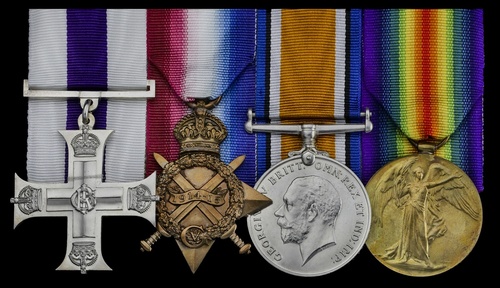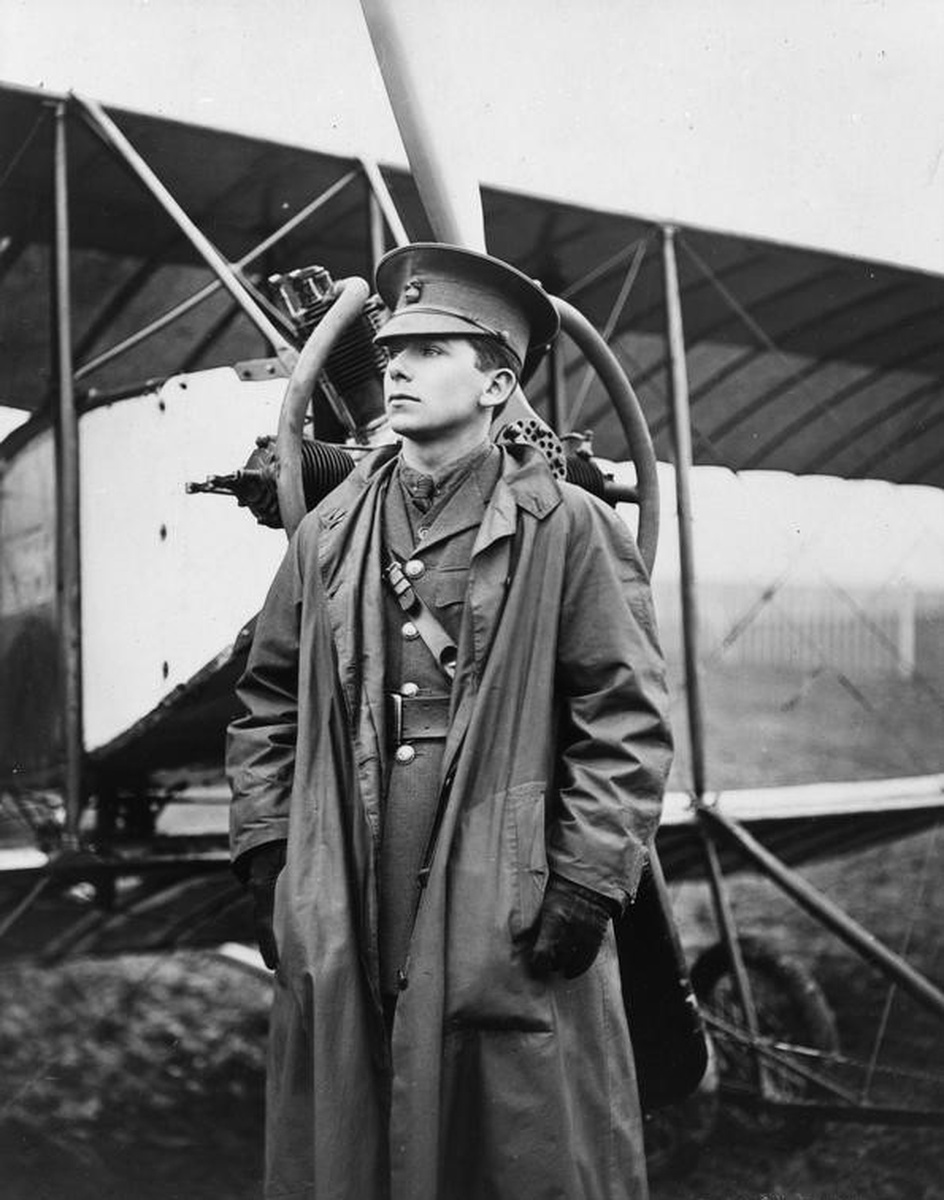Auction: 19002 - Orders, Decorations and Medals
Lot: 402
'Thus after a career of daring venture against the enemy and countless narrow escapes which caused Richard to be called ‘the man with the long life’, suddenly, in the twinkling of an eye, in the opening burst of machine gun fire, the Divine summons came'.
The Great War and Chalford, refers.
The exceptionally poignant - and historically important - Great War Squadron C.O.'s M.C. group of four awarded to Major R. 'Dick' Raymond-Barker, No. 3 Squadron, Royal Flying Corps, late Northumberland Fusiliers, the last fatal victim of Baron von Richthofen
An ace in his own right, Raymond-Barker was decorated for stoically taking photographs of enemy positions despite repeated attacks by enemy aircraft; on 20 May 1917, though badly outnumbered, he shot down two Albatros D.III fighters in rapid succession
He commanded No. 3 Squadron during its fateful engagement with Jasta 11 on 20 April 1918, when the Red Baron and his circus got onto his tail and sent his Sopwith Camel spiralling in flames to its destruction. The Red Baron claimed one further 'victory', before himself being shot down just 16 hours later
Military Cross, G.V.R., unnamed as issued; 1914-15 Star (Lieut. R. Raymond-Barker. R.F.C.); British War and Victory Medals (Major R. Raymond-Barker. R.A.F.), nearly extremely fine
Exhibited:
Scramble, Spink, April 2018.
M.C. London Gazette 17 September 1917:
'For conspicuous gallantry and devotion to duty when leading a fighting patrol. He attacked a large hostile formation, destroying two of them. He has also done excellent work in leading distant photographic reconnaissances, notably upon two occasions when his skilful leadership enabled photographs to be taken of all the required hostile area in spite of repeated attacks from enemy aircraft. He has helped to destroy seven hostile machines and has at all times displayed conspicuous skill and gallantry.'
Richard Raymond-Barker - or Dick to his friends and comrades - was born on 6 May 1894 at Forest Gate, London, the third son of Edward and Rose Mary (née Crawford) Raymond-Barker. One of nine children, he was brought up at 'Paulmead', a landed estate in the village of Bisley, Gloucestershire. Educated at Wimbledon College, he then gained employment laying submarine cables from Sydney to Auckland aboard the telegraph steamer Silverton. He took part in similar cable-laying projects on the west and south-east African coasts, before moving to Canada to take up farming.
With the onset of the Great War, he immediately returned to England and enlisted as a Private soldier in the Middlesex Regiment. Within three months he had been promoted to Sergeant. Commissioned 2nd Lieutenant in the 5th Battalion, Northumberland Fusiliers on 30 November 1914, he learnt to fly at his own expense, gaining his Royal Aero Club Certificate (No. 1460) at Hendon Aerodrome on 18 July 1915. He served in France from 22 November 1915 but clearly had his eyes on the skies. On 6 August 1916 he was seconded to the Royal Flying Corps, gaining his 'Wings' as a Flying Officer on 19 October. On 22 November he was assigned to No. 6 (Army Co-operation) Squadron in France. Equipped with BE2c two-seater biplanes, No. 6 Squadron was responsible for observing the effects of Allied artillery fire and giving reports to gunners on the ground. He then transferred to No. 16 Squadron, commanded by Major Hugh Dowding and was rapidly promoted to Acting Captain and Flight Commander.
Raymond-Barker was posted to Major Keith Park's No. 48 Squadron, equipped with Bristol Fighters, on 12 May 1917, but managed to 'drop in' home as reported in The Stroud News:
'Much excitement was caused in quiet Bisley at noon on Tuesday when a large battleplane was observed to hover over the village and gradually to plane down to within two hundred feet of the houses. At first it was thought that the airman was in difficulties, as at one time the machine seemed to side slip dangerously, the next to turn almost tail downwards. A close observer could see that the airman was enjoying himself, as he had complete control of his charge, and that he was treating onlookers to a thrill or two.
The children, especially the boys, were full of interest, and one keen youngster noticed the airman drop something in a field known as Paul Mead at the lower end of the village. He ran and picked it up, and found it to be a small box, addressed to Mr Raymond-Barker, a well-known and much respected Bisley resident. He took it to Mr Barker, who found it contained a message from his son, Captain Richard Raymond-Barker, RFC, now with an air squadron at Rendcomb. Captain Raymond-Barker was the intrepid airman, who in this novel way visited his home and communicated with his parents. After hovering round within the precincts of the village for a short time longer the battleplane disappeared rapidly in the direction of Cirencester. When afternoon school commenced, the boy who had taken the message, brought with him to school from Mr Barker a box containing portions of the metal shaft and the wooden axle of a broken propeller.
An affixed note stated that these were what remained of the propeller of Captain Raymond-Barker’s aeroplane, when, as a 2nd Lieutenant and Pilot, on the 26th January last year, he, with 2nd Lieutenant Nixon as Observer, planed over the German lines at Ypres taking observations, at a height of 7,000 feet, the propeller was smashed by a shell from a German ‘Archie’.
Captain Barker, however, by sheer grit and skill cleverly manipulated his damaged plane, and solely by the force of gravity returned safely 11 miles back to the English lines. Captain Raymond Barker has led several bombing squadrons by day and night in France during last year, and has done good work. He is returning to France at an early date in charge of a new squadron. His younger brother, also a brave and clever British airman is now unfortunately a wounded prisoner with the enemy. Mr and Mrs Raymond Barker have good reason to be proud of their brave sons.'
He was quickly into the action and at 1230hrs on 20 May, while piloting A7112, he shot down two Albatros D.III fighters over Brebieres. This was followed by another Albatros D.III, which crashed east of Brebieres at 1950hrs on 26 May. He accounted for an Albatros C.I east of Bullecourt at 0730hrs on 5 June. On 2 July he transferred to No. 11 Squadron, also equipped with Bristol Fighters. It was while piloting A7143 that he gained 'ace' status, downing an Albatros D.V over Bohain at 1900hrs on 8 July. His sixth and final aerial victory occurred at 0745hrs on 18 July, when he shot down an Albatros D.III over Inchy - gaining a well-deserved M.C. in the process. That same month, he was promoted to Major and given command of No. 3 Squadron, equipped with Sopwith Camels and based at Valheureux in the Somme valley.
Journey's end - down in flames
Awarded his M.C. by King George V at Buckingham Palace in February 1918, Raymond-Barker had just weeks to live. At 1800hrs on 20 April, while flying Sopwith Camel D6439 as part of a No. 3 Squadron offensive patrol, six Fokker triplanes were spotted east of Villers-Bretonneux. They were painted in an array of colours - blue, green and white, and red. This denoted their elite status as Jasta 11, the famous 'Flying Circus' of German aces. In the red plane was Baron Manfred von Richthofen - a worthy antagonist that Raymond-Barker is noted to have wished to meet in battle - already with 78 kills to his name. Captain D. J. Bell, who flew No. 3 Squadron's leading plane during the engagement, later recalled how his comrades centred their efforts on the Red Baron, trying desperately to bring him down. Captain C. M. Lemon fired 100 rounds into the dreaded red triplane's fuselage, while 2nd Lieutenant C. M. Kinney dived down onto it, firing 150 rounds into the cockpit. Their fire seemed to have no effect; the Baron was unstoppable. Raymond-Barker was pursuing another Fokker when the red triplane appeared in his rear. In his subsequent combat report, the Red Baron stated:
'With six planes of Jasta 11, I attacked a large enemy squadron. During the fight I observed that a Triplane was attacked and shot at from below by a Camel. I put myself behind the adversary and brought him down, burning, with only a few shots. The enemy plane crashed down near the forest of Hamel where it burned further on the ground.'
Raymond-Barker's body was never found. His death at the age of 23 marked the Red Baron's 79th aerial victory, and he was the Baron's last fatal victim. 2nd Lieutenant Lewis of No. 3 Squadron was shot down during the same engagement, his plane crashing just yards from Raymond-Barker's, but Lewis was thrown out of the plane unscathed despite hitting the ground at something like 60mph. He staggered to the burning wreckage of Raymond-Barker's Camel and attempted to pull him from the flames, but he was too late. Lewis later recalled that the Red Baron flew over the wreckage and waved to him, presumably thinking he was a German as he recorded his opponents as finis (doubtless the Baron wanted someone to witness and confirm his two victories). Having claimed 80 kills, Baron von Richthofen was himself shot down at Beaucourt-en-Senterre at 1025hrs on 21 April, just hours after Raymond-Barker's demise.
Raymond-Barker is commemorated on the Arras Flying Services Memorial, France. A comrade offered a fitting tribute:
'He was so awfully jolly with no standoffishness on account of his position, and always did the dangerous jobs with his Squadron.'
Sold together with a file of copied research and MIC.
Subject to 20% VAT on Buyer’s Premium. For more information please view Terms and Conditions for Buyers.
Sold for
£15,000
Starting price
£9500







